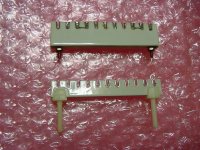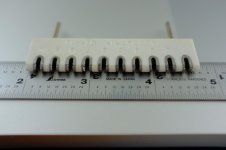Thanks for the info. I saw a photo of one with a threaded insert to take a screw through the chassis for mounting. No indication what company might have used it but the reported experience with Tek strips was so unlike my own I wondered if I simply had the wrong type. Apparently not - though I'm a little surprised as the ones I have are around 3/16" through at the bottom of the slot and the same again in height with the material itself being a good 1/16" thick. That's a fair bit of mass once you've got some leads or wire in there. I'll give them another go with the recommended solder. Thanks HS
I will admit that soldering on these ceramic strips is not the easiest thing to do at first. But there is kind of a trick to it. You must use a hot enough iron to heat the insert and flow the solder. The trick is to work quickly. Heat, flow the solder in and get off it. Don't linger any longer then necessary. I use a Weller soldering gun type 8200. It's a dual heat (100/140 watts). I also use regular 60/40 Kester solder. Lead free solder stinks because it just doesn't work. I never use it. But this technique takes practice and it is something you just have to learn regarding how long you can stay on the insert. And it's actually a little longer then you might think.
The picture below shows the old type with threaded studs and the newer style on the bottom with plastic fastners. These seem to be bonded on rather then snap on.
The picture below shows the old type with threaded studs and the newer style on the bottom with plastic fastners. These seem to be bonded on rather then snap on.
Attachments
Tek were very specific, NOT to use a Leaded Solder, they specified that lead will 'leach' out of the joint and cause issues,--I dunno, read it in some Tek service data some time.
Ive used that horrible 'Lead-Free' solder with good success on the ceramics of Tek scopes, although I agree, Lead-Free sucks BIG time!
Ive used that horrible 'Lead-Free' solder with good success on the ceramics of Tek scopes, although I agree, Lead-Free sucks BIG time!
I will admit that soldering on these ceramic strips is not the easiest thing to do at first. But there is kind of a trick to it. You must use a hot enough iron to heat the insert and flow the solder. The trick is to work quickly. Heat, flow the solder in and get off it. Don't linger any longer then necessary. I use a Weller soldering gun type 8200. It's a dual heat (100/140 watts). I also use regular 60/40 Kester solder. Lead free solder stinks because it just doesn't work. I never use it. But this technique takes practice and it is something you just have to learn regarding how long you can stay on the insert. And it's actually a little longer then you might think.
The picture below shows the old type with threaded studs and the newer style on the bottom with plastic fastners. These seem to be bonded on rather then snap on.
Thanks for posting the photo. Now it's clear that they're not exactly the same. The ones I have were produced by Alco Electronics in Lawrence Mass. and manufactured in Japan as Alcostrip under license from Tektronix. I'll remember your tips when I use them. No soldering gun but a desoldering gun likely has about the same thermal mass and will probably give similar results.
Attachments
- Status
- Not open for further replies.

